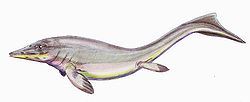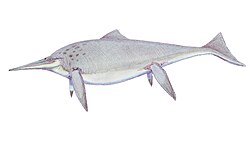Hueneosauria: Difference between revisions
Appearance
Content deleted Content added
Moved one family to satisfy the alphabetic order Tags: Mobile edit Mobile web edit |
|||
| Line 8: | Line 8: | ||
| subdivision_ranks = Subgroups |
| subdivision_ranks = Subgroups |
||
| subdivision = |
| subdivision = |
||
* {{extinct}}'''[[ |
* {{extinct}}'''[[Mixosauridae]]''' |
||
* {{extinct}}'''Longipinnati''' |
* {{extinct}}'''Longipinnati''' |
||
| ⚫ | |||
** {{extinct}}[[Cymbospondylidae]] |
** {{extinct}}[[Cymbospondylidae]] |
||
| ⚫ | |||
** {{extinct}}'''[[Merriamosauria]]''' |
** {{extinct}}'''[[Merriamosauria]]''' |
||
}} |
}} |
||
Latest revision as of 22:12, 7 April 2025
| Hueneosauria Temporal range: Early Triassic - Late Cretaceous
| |
|---|---|

| |
| Partial skull of Cymbospondylus petrinus | |
| Scientific classification | |
| Domain: | Eukaryota |
| Kingdom: | Animalia |
| Phylum: | Chordata |
| Class: | Reptilia |
| Order: | †Ichthyosauria |
| Node: | †Hueneosauria Maisch & Matzke, 2000 |
| Subgroups | |
| |
The Hueneosauria are a group of Ichthyosauria, living during the Mesozoic.
In 2000, Michael Werner Maisch and Andreas Matzke defined a node clade Hueneosauria as the group consisting of the last common ancestor of Mixosaurus cornalianus and Ophthalmosaurus icenicus; and all of its descendants. The clade is named after Friedrich von Huene, a German paleontologist who was a leading ichthyosaur expert in the early twentieth century.[1]
The Hueneosauria contain the more derived ichthyosaurs, which have the morphology of a fish. The group originated in the early Triassic and became extinct during the Cretaceous.
References
[edit]- ^ Maisch, M. W.; Matzke, A. T. (2000). "The Ichthyosauria". Stuttgarter Beiträge zur Naturkunde, Serie B. 298: 1–159.








